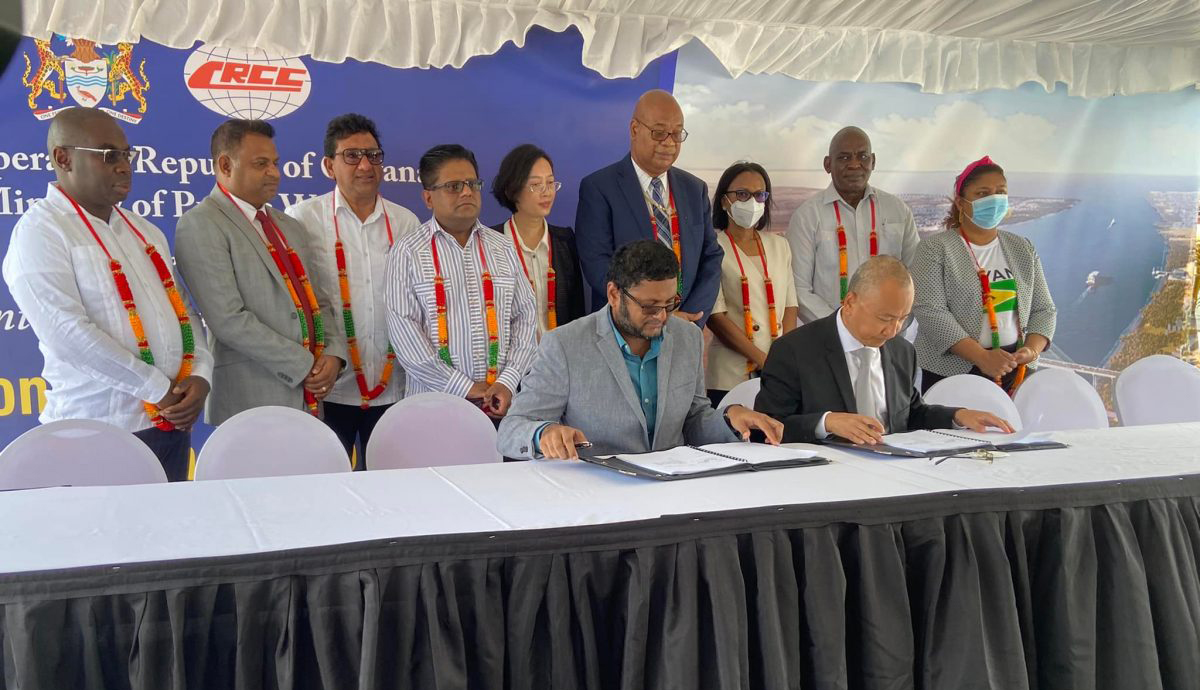The two-year construction timeline for the new Demerara Harbour Bridge insisted on by the government will remain, but negotiation with the builder, China Railway Construction Company Limited (CRCCL), has now seen the US$25,000-per-day penalty reduced to US$15,000, says Minister of Public Works, Juan Edghill.
“The penalty was not taken out but the negotiated sum is now US$15,000 per day…” Edghill told Stabroek News on Wednesday when asked about terms of the new contract.
Government had put in the draft contract documents that it wants the bridge to be built in two years and that for every day outside of that timeframe, a US$25,000 penalty would be incurred. “Capital cost increases if completion is projected to take beyond 2 years – imputed penalties; [US$25,000.00] per day,” the document had stated.
Sources had last year told Stabroek News that bidders were concerned about the rigidity of the terms, but when government later met with prospective bidders, none of them had raised those issues.
The contract to build the estimated US$260 million bridge was signed in May of this year between the government and CRCCL. This was after months of technical and financial negotiations with the most responsive bidder – China State Construction Engineering Corporation (CSCEC) – fell through.
Under the CSCEC contract, the US$25,000 per day penalty was held, but “as part of negotiations”, this time around, government agreed to lower the sum.
Asked the reasons for the lowering of the penalty, the Minister of Public Works explained that as part of the strategic bargaining process between the two sides, government understands that “you don’t get everything” and compromised on lowering the sums but keeping all the other terms.
He was quick to point out that the contract still holds a firm penalty clause and that government would be holding the contractor to the signed agreement.
Meanwhile, Edghill echoed what he had stated earlier this month that preparatory works for the new bridge had begun.
“The company has begun preparatory work; administrative things, getting mobilized; getting their equipment, sourcing materials, engineering testings… and are keeping us up to date. As you know also, there was a tender for supervisory works and that is still being evaluated… So we are at that stage and I hope soon we will get the supervisory consultancy to manage the project…”
He added, “Nothing has changed and preparatory and mobilization by the company continues.”
This newspaper understands that an agreement has been reached with the contractor and the owner of lands in the Peters Hall, East Bank Demerara area, to be used as a mobilisation and storage site.
With regard to the consultancy procurement, sources at NPTAB have informed that while details on the evaluation process cannot be made public while ongoing, “it is wrapping up.”
It is hoped that by early September that process would be completed.
The contract for a supervisory consultancy had to be retendered as eight companies had in March of this year bid for works that would have been done by CSCEC.
But five days after the contract was signed for the construction of the bridge, Financial Proposals were opened for supervisory consultancy services on May 31 for CRCCL’s works and again, eight companies submitted.
While some of the previous bidders also bid, some did not.
Those bidding, according to the NPTAB’s website were Figg Bridge Inspection Inc in association with E & A Consultant, Dan. B. & Associates, at a cost of US$459,460, US$7,739,312; RITES Limited in association with CB Associates Inc – US$9,412,830, US$2,026,804; Dyrock Acuitas Consortium – US$2,630,925, US$11,665,806; WSP Del Istmo S:De R.L Infinity Service Inc – US$6,774,360, US$1,131,976; Egis Group Consortium – US$1,396,503, US$5,236,888; Polite Ingegneria in association with SRKN Engineering Associates – US$4,400,000, US$440,000; RAISE International in association with CEMCO Inc, Stantec Consulting International LLC – US$2,192,676, US$15,661,973; and Daraya Enterprise Limited in association with BCC Engineering LLC – US$16,458,213.
The construction of the bridge will utilise a Design-Build-Finance (DBF) model. It is estimated that construction will last for two years. The bridge will be 2.65 kilometres long with a driving surface width of 23.6 metres to accommodate four lanes. The high-span fixed bridge will fall in the vicinity of the current location and terminate at Nandy Park on the East Bank of Demerara. The bidding document states, “The new design of the Demerara Harbour Bridge will not require opening or retraction to allow for maritime traffic and will be built with a life span of at least 50 years.”
There has been a major controversy over the decision by the Environmental Protection Agency not to require an Environmental Impact Assessment for the project.
Commuters crossing the existing Demerara Harbour Bridge have paid what are considered to be relatively low rates for decades as opposed to travellers over the Berbice Bridge which had been constructed under a Build, Own, Operate and Transfer model. Over the period that the Berbice Bridge has been in operation there have been unrelenting pleas for the lowering of fares.









